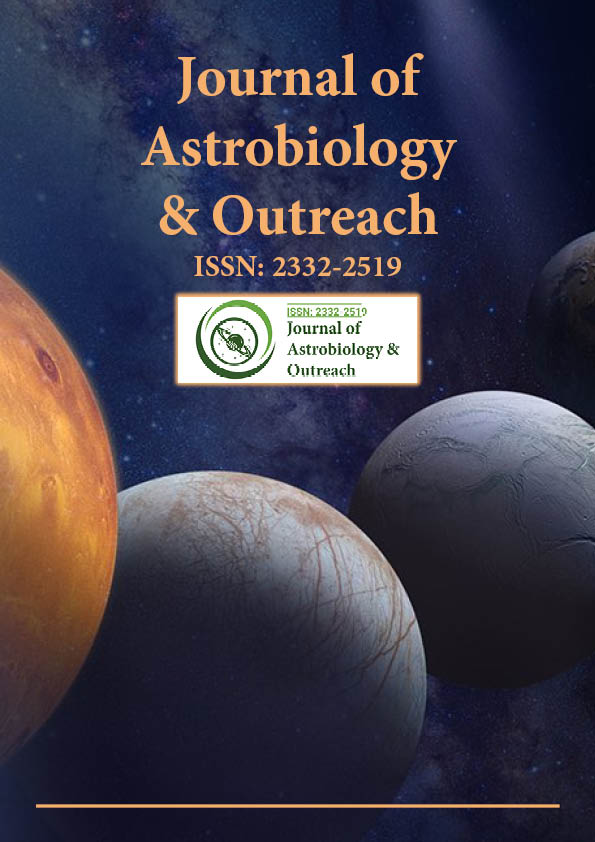Indexed In
- Open J Gate
- Academic Keys
- JournalTOCs
- RefSeek
- Hamdard University
- EBSCO A-Z
- OCLC- WorldCat
- Google Scholar
Useful Links
Share This Page
Journal Flyer

Open Access Journals
- Agri and Aquaculture
- Biochemistry
- Bioinformatics & Systems Biology
- Business & Management
- Chemistry
- Clinical Sciences
- Engineering
- Food & Nutrition
- General Science
- Genetics & Molecular Biology
- Immunology & Microbiology
- Medical Sciences
- Neuroscience & Psychology
- Nursing & Health Care
- Pharmaceutical Sciences
Perspective - (2024) Volume 12, Issue 2
Advancements in Compton Camera Technology for Gamma-Ray Astronomy
Chenxi Yuan*Received: 28-May-2024, Manuscript No. JAO-24-27365; Editor assigned: 31-May-2024, Pre QC No. JAO-24-27365 (PQ); Reviewed: 14-Jun-2024, QC No. JAO-24-27365; Revised: 21-Jun-2024, Manuscript No. JAO-24-27365 (R); Published: 28-Jun-2024, DOI: 10.35248/2332-2519.24.12.344
Description
The Compton camera is an advanced instrument used in gamma-ray astronomy, specifically designed to detect high-energy photons and create images of gamma-ray sources in space. Gamma rays, which are the highest-energy form of electromagnetic radiation, originate from some of the most extreme environments in the universe, such as supernova explosions, neutron stars, black holes and interactions of cosmic rays with interstellar matter. Through the unique capabilities of the Compton camera, astronomers have gained insights into these distant and powerful processes, offering a better understanding of high-energy events across the cosmos. The camera’s functionality is based on the principle of Compton scattering, an interaction in which a gamma-ray photon collides with an electron, transferring part of its energy and deflecting in a new direction. By analyzing these scattering events, the Compton camera measures both the energy of the scattered photons and their deflection angles. This allows determining the original direction of incoming gamma rays, making it possible to reconstruct an image of the gamma-ray source. One of the Compton camera’s most important features is its wide field of view, which allows it to observe large sections of the sky simultaneously. This feature is particularly beneficial for capturing transient sources of gamma rays, such as Gamma-Ray Bursts (GRBs). These bursts are brief but intense flashes of gamma radiation, likely resulting from explosive events such as stellar collapses or neutron star collisions. Since they occur unpredictably, the Compton camera’s ability to monitor broad sky areas at once increases the likelihood of capturing these events and gathering critical information about their origins.
The structure of the Compton camera generally involves multiple layers of detectors, each serving a specific purpose. The initial layer captures the first Compton scattering event, providing the scattered photon’s trajectory details. As the photon travels through subsequent layers, further interactions refine the path data, allowing for the precise reconstruction of the gamma-ray source’s location. This multi-layered setup enables scientists to pinpoint high-energy sources accurately, which is essential for investigating cosmic phenomena such as black holes and supernova remnants. The Compton camera is also valuable for examining high-energy cosmic sources beyond GRBs, including neutron stars. Neutron stars, which are remnants of collapsed massive stars, have strong magnetic fields that can create gamma rays through particle interactions. Observing gamma rays emitted by neutron stars offers insights into their magnetic structures, spin rates and surface conditions, contributing to a deeper understanding of these dense and complex objects. Another application of the Compton camera is in studying diffuse gamma-ray backgrounds, which arise from a combination of sources and are challenging to analyze. Observing these diffuse backgrounds provides clues about astrophysical processes occurring across the universe, including possible signals of dark matter. Some theoretical models suggest that dark matter particles could produce gamma rays under certain conditions. By focusing on regions suspected to contain high concentrations of dark matter, such as galactic centers, the Compton camera may help identify signs of dark matter activity.
The camera also assists in studying cosmic rays’ interactions with interstellar matter. Cosmic rays are high-energy particles that travel through the galaxy, producing gamma rays when they collide with interstellar gas and dust. By analyzing these gamma rays, scientists can learn about cosmic rays’ origins, pathways and interactions within the galaxy, shedding light on high-energy particle propagation and the structure of the galaxy. Advancements in Compton camera design have led to improved image quality, sensitivity and durability for long-duration space missions. Integrating advanced semiconductor technology into Compton camera designs has boosted sensitivity, allowing for the detection of fainter gamma-ray sources. This improved sensitivity also leads to higher imaging resolution, enabling scientists to observe gamma-ray sources in greater detail and at different scales. Recent space missions have incorporated gamma-ray detection technology, such as National Aeronautics and Space Administration (NASA) Fermi Gamma-ray Space Telescope and the European Space Agency’s INTEGRAL observatory. These missions have contributed significantly to gamma-ray astronomy and upcoming missions plan to use Compton cameras with even higher sensitivity. Observing lowerenergy gamma rays that current instruments may overlook, these next-generation devices promise further insights into cosmic events and high-energy interactions.
The Compton camera’s applications are not limited to space. On Earth, the camera’s technology has practical uses in fields such as medical imaging and nuclear safety. In medicine, adapted Compton cameras can detect gamma rays emitted by radioactive tracers within the body, helping diagnose certain conditions. Similarly, in nuclear safety and environmental monitoring, Compton cameras can detect gamma-ray emissions to locate and measure radioactive materials accurately. Although these applications are distinct from astronomy, they rely on similar principles of gamma-ray scattering and directional detection. The Compton camera’s role in gamma-ray astronomy provides a unique method for observing and understanding high-energy phenomena in space. As advancements continue, enhanced versions of the Compton camera will enable astronomers to create more detailed gamma-ray maps, uncovering new aspects of the processes that shape galaxies, stars and other celestial bodies. This instrument exemplifies scientific progress in our understanding of some of the most energetic and complex phenomena in the universe.
Citation: Yuan C (2024). Advancements in Compton Camera Technology for Gamma-Ray Astronomy. J Astrobiol Outreach. 12:344.
Copyright: © 2024 Yuan C. This is an open-access article distributed under the terms of the Creative Commons Attribution License, which permits unrestricted use, distribution, and reproduction in any medium, provided the original author and source are credited.

